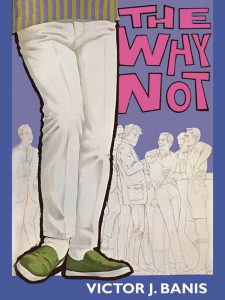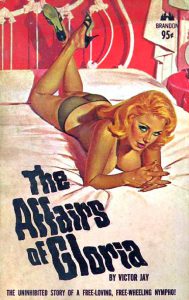 The Why Not, Victor Banis, A Greenleaf Classic, 1966
The Why Not, Victor Banis, A Greenleaf Classic, 1966
Best Line: “The Why Not represented everything he disliked about gay bars–screaming faggots, drag queens, rough trade. It was cheap and tawdry and, probably because of those qualities, successful.”
The above describes the book as well as the bar. I’ve been doing a little research on gay male pulp, in preparation for the upcoming pulp panel, and from what I’ve read The Why Not was the Women’s Barracks of the genre, a ground-breaking novel that led the way for books like Midtown Queen and Hot Pants Homo. It was written by the prolific Victor Banis, best known for his Man from C.A.M.P. series, and it seemed like a good first stop on my visit to the boy’s side of pulp town.
The Why Not was a great place to start. It packs dozens of characters and incidents into its 166 pages, in a kind of Ann Aldrich survey of L.A. gay life without the faux-sociological framework. We meet fey young men, sex addicts, drag queens, domesticated partners, conflicted hitchhikers, Greek sailors, married closet cases, queeny antique collectors with a penchant for rough trade, and a bored, closeted movie star who watches himself on television while being serviced by a young hunk. There’s cruising, pickups, anonymous groping, seduction, daisy chains, and orgies. It’s got anonymous phone calls, blackmail, armed robbery, gay-bashing, entrapment, police raids, rape and murder. There’s even a surprise gender-bending twist at the end that I’m still trying to make sense of.
The Plot: There isn’t much continuous story, but who cares? The book covers a day and a night, organized into time slots, i.e. “11:59 a.m., Saturday”, “4:39 p.m.”, “10:02 p.m.”, etc. ending “1:50 a.m., Sunday”. Within each section there are half-a-dozen or more episodes (a guy cruises a teenager on a bus, a drag queen calls a friend to gossip, a guy puts a cake in the oven and mixes a martini for his boyfriend) some with recurring characters, lots with men you never see again. The organizing factor is The Why Not, the gay bar they’re all coming from, or going to, or already at. The book starts and ends with an anonymous first person narrator, who I nicknamed the sex addict because he’s either having sex or pursuing it in every single one of his scenes. In the first scene he’s waking up next to a stranger, in the last scene he’s letting an older guy blow him for $5.
The other “plot line” is the Jackie-Lon-Lindy triangle. Lindy owns The Why Not, Jackie works there, Lon and Jackie are lovers. At first you think that Jackie is also the kept boy of the older Lindy, who knows about Lon but doesn’t realize Jackie and Lon are serious. At one point (4:39 p.m.) Jackie goes to the doctor, and you think, uh oh, Jackie’s been sleeping around and caught the clap. However, at the end Jackie is revealed to be a girl! She and Lindy are brother and sister! Lindy disapproves of Lon, maybe because he’s supposed to be bi? I’m still unclear as to whether the clientele of the Why Not are aware that Jackie is a girl, whether Lon started out gay, and just why Lindy disapproves of their relationship. but maybe Victor was stingy with this information so as not to give away his shocking twist. Anyway, Jackie visits the doctor to find out why she’s not getting pregnant, and learns it’s not her; when Lon finds out he might be sterile, he dumps her, unable to take the insult to his manhood. I’m still not sure what Victor was getting at by making this story the through-line, but I’m guessing he was going for some kind of “gays and straights aren’t so different” message.
Sex: Nonstop. Sex on the beach, in a car, at the baths (“a snake pit of arms and legs, bodies writhing and twisting together, the smell of sperm overpowering and alarming.”); a public blow-job in a piano bar, a daisy chain at a party, sleepovers between questioning teens…the list goes on. “I feel like a stripper in a three-shows-a-night club,” says Jackie, after climbing out of bed with Lon for the second time in one morning. There’s not a lot of physical detail, just the facts, ma’am, the when, where, who and how. The most affectionate sex happens between some Greek sailors and friendly gay locals who all go to a motel together. That particular episode had a nice On The Town, “Where has the time all gone to” poignancy. Otherwise having sex is just like eating: sometimes you’re hungry, sometime you just eat out of habit, or because the food is free, or…you get the point.
Drinking: Moderate. Lots of smoking though–all those post-coital cigarettes add up.
Violence: It’s dangerous being a homo, this book makes clear. The episode in which Mike picks up a teenager and has sex with him, only to have the boy turn violent afterwards rang scarily true (“he was one of the dangerous ones, dangerous and strangely pathetic.”). However, the episode in which Dennis is beaten and raped by an undercover vice cop wins most disturbing award. The author includes a gay-bashing, but makes the victim a tolerant straight man, who just happens to be at a bus stop near The Why Not at the wrong time. I guess this was to make it clear how truly wrong gay bashing is–because the guy you’re killing might be as straight as you! This unlucky victim is so heterosexual that he’s been widowed and is planning to propose to his current girlfriend just…before…homophobes bash his head in.
Homo Psychology: There’s more sociology than psychology, as the book obsessively catalogs every gay type Banis can think of: the dumb hunks, the sensitive young men the leather boys, the flaming queens. On the a whole, he paints a sympathetic portrait; villainous gay behavior (the older antique lovers who get a hick falling down drunk so they can have their way with him) is more than counterbalanced by the many, many ways in which gay men are victimized by society. But even if they’re not demonized, these boys are an awfully unhappy bunch, excepting the cheerful Greek sailors.
 Victor’s Take: “Reading it now, I don’t think that The Why Not was an especially good novel. Certainly it stayed too close to the sad-young-men school of writing that I later refuted–but historically it was certainly a significant one, setting a precedent as it did for the coming groundswell in gay publishing.”
Victor’s Take: “Reading it now, I don’t think that The Why Not was an especially good novel. Certainly it stayed too close to the sad-young-men school of writing that I later refuted–but historically it was certainly a significant one, setting a precedent as it did for the coming groundswell in gay publishing.”
–from Banis’s memoir, Spine Intact, Some Creases, which contains lots of good stuff on sixties era paperback publishing, including the story of how Banis was charged with obscenity for his first paperback, a lesbian pulp called The Affairs of Gloria (1964).
Comment: This read a little like Edmund White’s autobiographical fiction crossed with a Sid Davis scare film, but it sure kept me turning pages. I particularly liked the way ironic coincidences multiplied as Saturday night turned into Sunday; not only the straight man taken for a gay man and killed, but the way Dennis was the victim of the undercover vice cop when he almost never went to the bar! And the way Bob goes to an after hours party to kill time because his boyfriend Andy is on night duty, and the party gets raided and Andy is one of the cops making the arrests! After I finished the book I looked up Victor Banis’s memoir and was shocked to discover that Lady Agatha, the daisy-chaining drag queen, was based on a close friend of Victor’s. I’d been under the impression that the author looked down on drag queens. In my notes I wrote, “on the whole [a] negative portrayal–self-centered and shallow.” It just goes to show that the wall that lies between one’s present world (middle-aged literary lesbians in the 2010s) and another’s past world (bar-hopping gay boys in 1960s LA) is more insurmountable than you think, and perhaps it is impossible to truly comprehend the past, no matter how many period newspapers and journals and pulp novels one reads.
